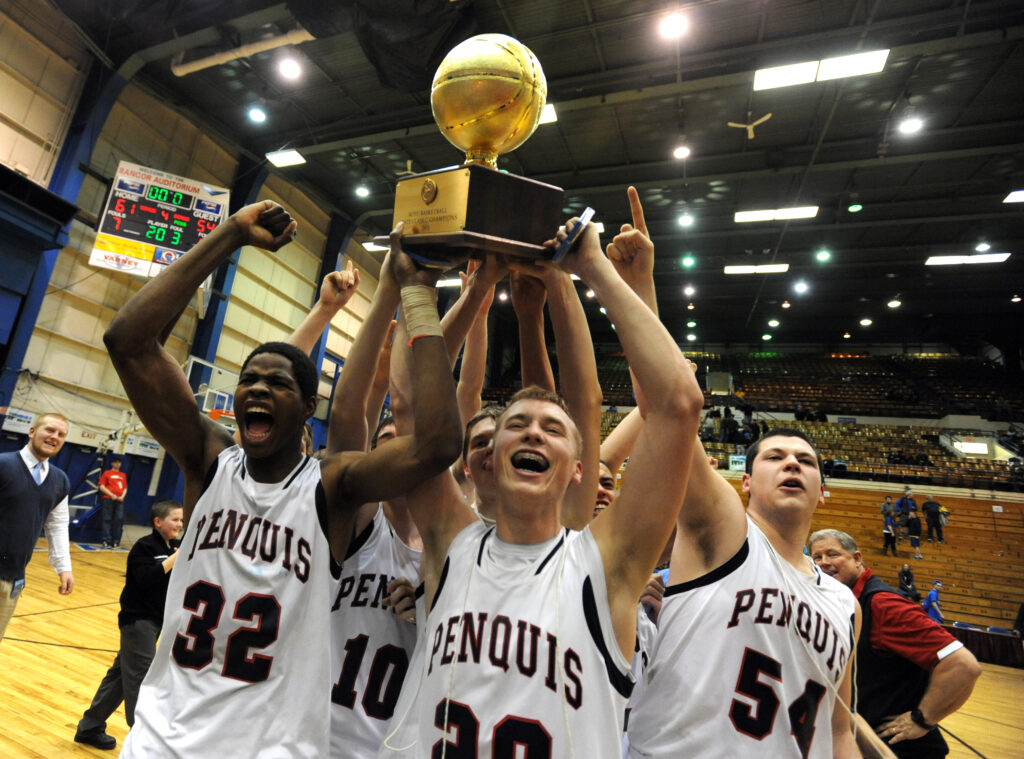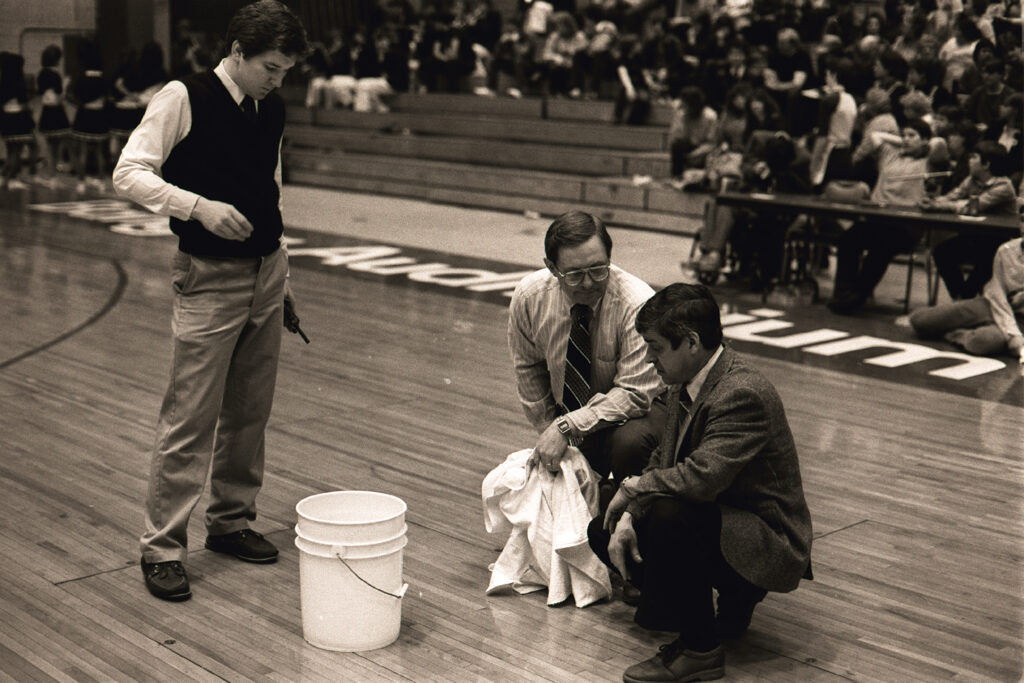
Bangor Auditorium was beloved despite problems
By Emily Burnham, Bangor Daily News Staff
Ten years ago, the last squeaking sneakers, swishing baskets and roaring crowds could be heard echoing into the rafters of the Bangor Auditorium.
The last high school basketball tournaments were played in March 2013 in the auditorium — the very last game featured the Penquis Valley boys claiming the Class C championship with a 61-54 victory over Boothbay of March 2 of that year — which was slated for demolition in June of that year in order to make way for the new Cross Insurance Center.
While it was bittersweet for athletes, coaches and fans, it was a necessary development to create a modern, accessible municipal facility. The Cross Center, where the Class B, C, and D tourneys are being played this week, is a far cry from its predecessor — but aside from the nostalgia factor, that’s mostly a good thing.
The Bangor Auditorium replaced the original auditorium built in 1897 at what is now known as Bass Park. It could seat 1,700 people. By the 1940s, the city had long outgrown it, and though the new auditorium was built right next to the old one, the original stood for another 10 years before it was torn down in 1965.

CLOSING OUT THE AUDITORIUM — Isaiah Bess, Trevor Lyford, and Justin Larry, along with the rest of the Penquis Valley Patriots, carry the gold ball for fans after a 61-54 victory over Boothbay Regional High School at the 2013 Class C championship at the Bangor Auditorium. The game was the very last held at the venue before it was demolished and replaced with the Cross Insurance Center later in 2013.
In the early 1950s, the city hired Bangor architect Eaton Tarbell to design the new facility, which would be nearly four times larger than the old one and the second-largest sports facility in New England, after Boston Garden. Tarbell was a student at Harvard of famed modernist architect Walter Gropius, who designed landmark structures such as the MetLife Building in New York City and the Harvard Graduate Center in Cambridge, Massachusetts.
Tarbell was one of the main proponents of modern architecture in Maine, encouraging organizations to adopt construction for new buildings, rather than the revival styles that dominated previous decades. The Bangor Auditorium, with its swooping V-shaped roof and glass facade, was arguably his most famous building.
Within a few years of its opening, the auditorium had become one of Maine’s largest and most popular gathering places for sports, entertainment, community events and visits from dignitaries. Over the decades, hundreds of concerts, fairs and other noteworthy events were held there — from rock bands and artists like Bob Dylan, KISS, Aerosmith and Phish to visits from then President Jimmy Carter and Barack Obama during his candidacy for president.
Regionally, the auditorium was perhaps most beloved for the tourneys. The eastern Maine high school basketball tournaments have been played in Bangor’s arena for more than 60 years, attracting thousands of spectators from all over the state. From the 1960s until that last event in 2013, the energy in the building was palpable, regardless of the size of the school or the talent of the players. When the bands were blaring and the crowd was roaring, it was an experience truly unique to Maine.
“There was nothing quite like the auditorium. It had a whole different energy to it. It had an old-school feeling to it and had an extra level of intensity,” Mike Gray, coach of the Gardiner High School girls’ basketball team, told the BDN earlier this month.
Part of the charm of the old auditorium was that it felt like a giant high school gymnasium — the kind of cavernous, no-frills wooden structure that was familiar to lots of basketball teams in Maine, just on a much bigger scale. Unfortunately, that was also part of the problem.

LEAKY ROOF — A leaky roof during the Eastern Maine Class B final between Dexter and Rockland on Feb. 21, 1986, was a sign of the problems to come for the Bangor Auditorium. Fred Olson, left, of the Auditorium staff, Alton “Bump” Hadley, tourney floor director, and Woody Dumphy, chairman of the tourney committee, ponder the problem. The game was played despite the leak and ended at 12:18 a.m. when Dexter defeated Rockland in five overtimes.
By the late 1980s, the auditorium was beginning to show its age. A series of major snowstorms damaged the V-shaped roof and caused leaks that were never fully fixed; country singer Kenny Rogers famously played a concert in 1988 in which water leaked directly on his head.
At its peak, the drafty auditorium burned through 90,000 gallons of oil over the winter — and with no air conditioning, in the summer, it was unbearably hot. Many of the old wooden seats were broken. And with just one elevator, much of the facility wasn’t accessible to people with disabilities.
Still events were held at the auditorium for nearly 25 more years, even as problems continued to mount and it became increasingly clear Bangor’s once refreshingly modern facility had degraded to a rickety old throwback. It would cost a lot of money to replace it, and progress in Bangor can, at times, be quite slow.
By late 2000s, an organized effort to build a new arena had coalesced, and by 2009, there were two camps: one that favored building, and another that favored repairing the old facility. The debate ran for several years, with strong opinions on both sides, but eventually, in a May 2011 election, Bangor residents voted by a ratio of 3 to 1 to approve the building of the new arena.
Construction on the new facility began in September 2011, and by spring 2013, work was nearly finished. After that last basketball tournament was played in March 2013, a few more events were held in the old auditorium, the last of which was Husson University’s graduation commencement in May.
Demolition began in June 2013, and within a few short weeks, the Bangor Auditorium — once the pride of eastern Maine and the site of generations of good times and triumphant moments in high school sports — was gone. Many people bought old seats from the building and kept pieces of the rubble as souvenirs.
In its place is the Cross Insurance Center, named for the Bangor-based insurance behemoth, which had its grand opening in September 2013. Where the auditorium was an architectural marvel of its time that was unique to Bangor, the Cross Center isn’t all that different from other similarly sized arenas in mid-sized cities across the country.
What it lacks in retro charm, the Cross Center makes up for in vastly upgraded amenities, as well as being far more energy efficient. It also has a roof that doesn’t leak. And besides: it’s not the venue that makes something special, whether it’s a basketball game, concert or speech. It’s the people there to be a part of it.